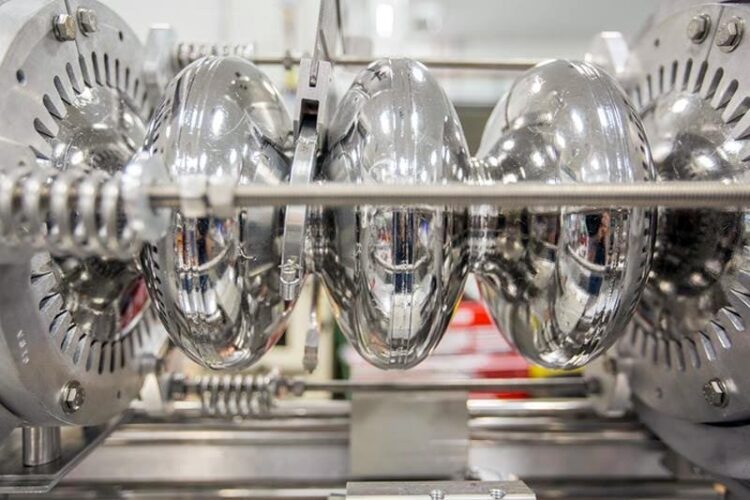Particle accelerators may get a boost from oxygen

Donut-shaped particle accelerator structures. Research indicates that accelerator performance may be improved by adding oxygen to the accelerator’s metal surface.
Image courtesy of the Department of Energy’s Thomas Jefferson National Accelerator Facility (Jefferson Lab)
Adding a little oxygen to particle accelerator structures may make them more efficient and easier to build.
The Science
Scientists have developed a new theoretical model for preparing particle accelerator structures made of niobium metal. The model predicts how oxygen in the thin oxide layer on the surface of the niobium metal moves deeper into the metal. This happens as the oxide layer dissolves during gentle heating. This heating is part of how a particle accelerator is made and prepared for use. Tests show that the model accurately describes the concentration profile of oxygen in niobium samples after the heat treatment. The tests also indicate that the treatment improves accelerator structure performance.
The Impact
Engineers and researchers compare the tradition of crafting world-class particle accelerator structures to perfecting a recipe – it takes trial and error. Using this new theoretical model would, for the first time, allow designers to customize the accelerator structure preparation ‘recipe’ without losing time to trial-and-error testing. The model offers a way to fine-tune the inclusion of impurities near the surface. Now this fine-tuning can be done in a simpler process with fewer steps. The model may help accelerator builders predict the optimum ‘recipe’ for their needs.
Summary
Researchers and industry use particle accelerators for a wide range of tasks, such as cancer treatment, scientific research, and searching for oil. Building more efficient accelerators can therefore benefit many different industries. Niobium metal structures power today’s most advanced particle accelerators, and the best accelerator structures were once made of the purest niobium. Recent studies show that adding small amounts of nitrogen to these structures can make them more efficient. Careful heating of accelerator structures using a simpler process can similarly enhance their performance.
In this study, scientists from the Jefferson Lab, Virginia Polytechnic Institute and State University, and North Carolina State University closely characterized a niobium heat treatment process that leads to enhanced performance. Oxygen was the key impurity in the enhancement. The researchers also developed a theory describing how the native niobium oxide layer dissolves during heating to describe how oxygen migrates into the niobium surface. They demonstrated that the theory reliably predicts oxygen profiles in test samples. The oxygen-alloyed niobium performed as well as nitrogen-alloyed niobium, increasing efficiency by 70 percent. In addition, the oxygen-alloying heat treatment process is simpler, cheaper and works on any accelerator cavity design. Because the process has less stringent requirements and fewer complicated steps, it should also be more easily reproduced at other facilities.
Funding
This material is based on work supported by the Department of Energy (DOE) Office of Nuclear Physics and the DOE Office of Science, Office of High Energy Physics.
Media Contact
Michael Church
DOE/US Department of Energy
michael.church@science.doe.gov
Office: 2028416299
Original Source
https://www.energy.gov/science/np/articles/particle-accelerators-may-get-boost-oxygen
All latest news from the category: Physics and Astronomy
This area deals with the fundamental laws and building blocks of nature and how they interact, the properties and the behavior of matter, and research into space and time and their structures.
innovations-report provides in-depth reports and articles on subjects such as astrophysics, laser technologies, nuclear, quantum, particle and solid-state physics, nanotechnologies, planetary research and findings (Mars, Venus) and developments related to the Hubble Telescope.
Newest articles

Innovative 3D printed scaffolds offer new hope for bone healing
Researchers at the Institute for Bioengineering of Catalonia have developed novel 3D printed PLA-CaP scaffolds that promote blood vessel formation, ensuring better healing and regeneration of bone tissue. Bone is…

The surprising role of gut infection in Alzheimer’s disease
ASU- and Banner Alzheimer’s Institute-led study implicates link between a common virus and the disease, which travels from the gut to the brain and may be a target for antiviral…

Molecular gardening: New enzymes discovered for protein modification pruning
How deubiquitinases USP53 and USP54 cleave long polyubiquitin chains and how the former is linked to liver disease in children. Deubiquitinases (DUBs) are enzymes used by cells to trim protein…


